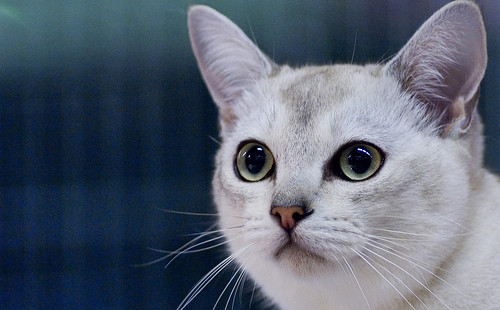
Burmilla by peter_hasselbom
The Burmilla is a breed of domestic cat which originated in the United Kingdom in 1981. It is a cross between the Chinchilla Persian and Burmese breeds.
Standards were produced in 1984 and the breed gained championship status in the United Kingdom in the 1990s.
Burmillas are medium-sized with muscular bodies, round faces, short muzzles and tend to weigh between 8-10 lb. A burmilla's eye color is usually green, although some cat societies accept blue (and yellow eyes are permitted in kittens). Black cats have eyeliner in black; other colours may have no lining or soft brown. The shape of their eyes are almond-shaped.
Coat length comes in three variants: The most common (standard) coat is the short-hair. This is a short, close-lying coat similar in appearance to the Burmese but with a softer, silkier feel. In addition there is a recessive longhair gene producing the Longhair Burmilla.
These cats have a semi-longhair coat lying close to the skin, with a soft, silky feel and a large plumed tail. The Shorthair gene is dominant, and where a cat receives one of each, the appearance will be Shorthair. Two Longhair Burmillas mated together will always produce Longhair kittens, while Shorthair matings depend on whether the Longhair genes are carried by the Shorthair parents.
Standards were produced in 1984 and the breed gained championship status in the United Kingdom in the 1990s.
Burmillas are medium-sized with muscular bodies, round faces, short muzzles and tend to weigh between 8-10 lb. A burmilla's eye color is usually green, although some cat societies accept blue (and yellow eyes are permitted in kittens). Black cats have eyeliner in black; other colours may have no lining or soft brown. The shape of their eyes are almond-shaped.
Coat length comes in three variants: The most common (standard) coat is the short-hair. This is a short, close-lying coat similar in appearance to the Burmese but with a softer, silkier feel. In addition there is a recessive longhair gene producing the Longhair Burmilla.
These cats have a semi-longhair coat lying close to the skin, with a soft, silky feel and a large plumed tail. The Shorthair gene is dominant, and where a cat receives one of each, the appearance will be Shorthair. Two Longhair Burmillas mated together will always produce Longhair kittens, while Shorthair matings depend on whether the Longhair genes are carried by the Shorthair parents.

Burmilla by ramtops
A third variant has been identified recently, that of the Plush. It is not professionally recognised as being separate from shorthair in judging, however plush kittens have much denser fur which does not lie closely against the skin. How the plush coat variant is inherited is not known.
The Burmilla can have a variety of coat colours, including black, blue, brown, chocolate and lilac. Although red, cream and tortoishell (calico) varieties have been bred, these colours are not recognised by most judging bodies. In addition the undercoat is either Silver or Golden, depending on the colour in the Persian heritage.
The Burmilla's shading comes in three major coat patterns which relate to the depth of colour. These are Tipped, Shaded and Smoke. Tipped Burmillas have at least 3/4 of their fur in the underlying colour (Silver or Golden) and the remainder is a light dusting of "colour" over the top. In the case of Silvers, these cats appear almost white. Shaded Burmillas have 1/4 - 1/2 as their colour, and Smoke have almost all colour with only a faint pale base to each hair.
The cats have nose leather which is red to pink (smoke cats have solid colour corresponding to their coat). In addition their paw pads correspond to the coat colouring: Black cats have black paw pads, Chocolate have brown-black, Brown cats have brown, both Blue and Lilac have pink.
The Burmilla can have a variety of coat colours, including black, blue, brown, chocolate and lilac. Although red, cream and tortoishell (calico) varieties have been bred, these colours are not recognised by most judging bodies. In addition the undercoat is either Silver or Golden, depending on the colour in the Persian heritage.
The Burmilla's shading comes in three major coat patterns which relate to the depth of colour. These are Tipped, Shaded and Smoke. Tipped Burmillas have at least 3/4 of their fur in the underlying colour (Silver or Golden) and the remainder is a light dusting of "colour" over the top. In the case of Silvers, these cats appear almost white. Shaded Burmillas have 1/4 - 1/2 as their colour, and Smoke have almost all colour with only a faint pale base to each hair.
The cats have nose leather which is red to pink (smoke cats have solid colour corresponding to their coat). In addition their paw pads correspond to the coat colouring: Black cats have black paw pads, Chocolate have brown-black, Brown cats have brown, both Blue and Lilac have pink.